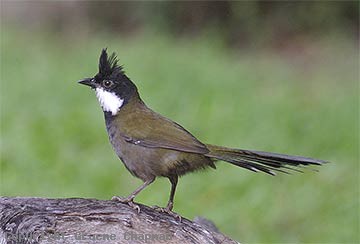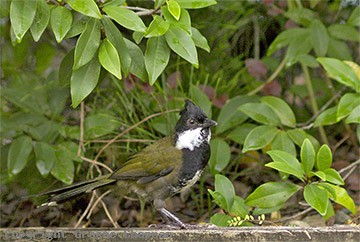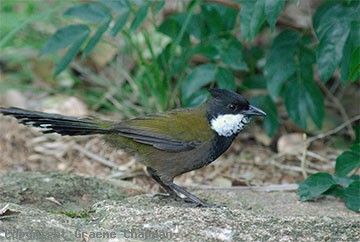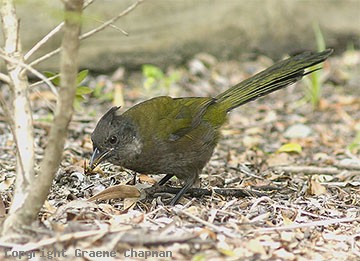
The Eastern Whipbird is one of the very few Australian birds whose name is derived from a description of the song.
The distinctive, loud "whip-crack" call of the male is one of the most well-known sounds of the Australian bush, although many people have never actually seen the bird. This is because most of the time, Eastern Whipbirds inhabit dense shrubbery where they forage most of the time on the ground, probing the litter for insects and keep largely out of view, except for the odd dash across an open space. However they are true omnivores, join the finches and doves at our seed feeder when available, and predators as well of eggs and nestlings of such small birds as Superb Fairy-wrens.
When adult, the sexes look alike. Adult plumage is acquired in the second year and younger birds are all-green at first, gradually acquiring the black and white markings through successive moults. Fully adult birds develop a pale-cream eye (see 421227D), how long this takes is not known, more than likely about four years. Adults maintain permanent territories of approx 5-10 hectares as pairs, and nesting can begin as early as July; the small cup-shaped nest is situated in dense shrubbery within a couple of metres of the ground. The female alone sits on the two eggs and he brings food to her at the nest. Both birds feed the young. Towards the end of the breeding season, usually after Christmas, adults and their young, not always together, wander further afield than the nesting territory and turn up in gardens in more rural situations in search of food. Our back garden is where most of these pictures were taken and some individuals do allow a closer approach. The bird in pic 421211 actually spent several months in our garden so we were able to observe his gradual change in plumage. Even more interesting was listening to him practise singing in some quiet spot - quite long sessions of a great variety of calls, including both male and female types - his amateur efforts at the "whip-crack" were almost comical to listen to.
Eastern Whipbirds inhabit the wetter coastal forests, including rainforest, and damp heaths of coastal eastern Australia from near Cooktown almost to Melbourne. Their near relatives, the Western Whipbird , Mallee Whipbird and the two Wedgebills have several obvious features in common - they are all crested, all lay beautiful blue eggs and adults all sing an antiphonal duet.




